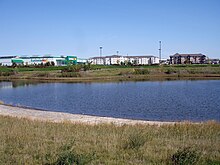
Back حوض التخزين Arabic Retenční nádrž Czech Regenrückhaltebecken German Bassin de rétention des eaux pluviales French Պարզարան Armenian Embung ID Тоспа әуіз Kazakh Neišleidžiamasis paviršinių nuotekų tvenkinys Lithuanian Retentiebekken Dutch Bazin de acumulare Romanian




A retention basin, sometimes called a retention pond, wet detention basin, or storm water management pond (SWMP), is an artificial pond with vegetation around the perimeter and a permanent pool of water in its design.[1][2][3] It is used to manage stormwater runoff, for protection against flooding, for erosion control, and to serve as an artificial wetland and improve the water quality in adjacent bodies of water.
It is distinguished from a detention basin, sometimes called a "dry pond", which temporarily stores water after a storm, but eventually empties out at a controlled rate to a downstream water body. It also differs from an infiltration basin which is designed to direct stormwater to groundwater through permeable soils.
Wet ponds are frequently used for water quality improvement, groundwater recharge, flood protection, aesthetic improvement, or any combination of these. Sometimes they act as a replacement for the natural absorption of a forest or other natural process that was lost when an area is developed. As such, these structures are designed to blend into neighborhoods and viewed as an amenity.[4]
In urban areas, impervious surfaces (roofs, roads) reduce the time spent by rainfall before entering into the stormwater drainage system. If left unchecked, this will cause widespread flooding downstream. The function of a stormwater pond is to contain this surge and release it slowly. This slow release mitigates the size and intensity of storm-induced flooding on downstream receiving waters. Stormwater ponds also collect suspended sediments, which are often found in high concentrations in stormwater water due to upstream construction and sand applications to roadways.
- ^ Water Environment Federation, Alexandria, VA; and American Society of Civil Engineers, Reston, VA. "Urban Runoff Quality Management." WEF Manual of Practice No. 23; ASCE Manual and Report on Engineering Practice No. 87. 1998. ISBN 1-57278-039-8. Chapter 5.
- ^ U.S. Environmental Protection Agency. Washington, D.C. "Preliminary Data Summary of Urban Storm Water Best Management Practices." Chapter 5. August 1999. Document No. EPA-821-R-99-012.
- ^ University of Florida Institute of Food and Agricultural Sciences. "If you build it they will come: Frogs flourish in humanmade ponds." ScienceDaily. ScienceDaily, 27 August 2015. <www.sciencedaily.com/releases/2015/08/150827154644.htm>.
- ^ Mississippi State University. College of Engineering. Stormwater Retention Basins. Chapter 4, Best Management Practices. Archived 2008-04-24 at the Wayback Machine
© MMXXIII Rich X Search. We shall prevail. All rights reserved. Rich X Search